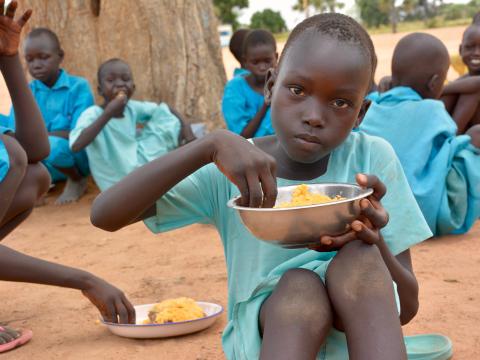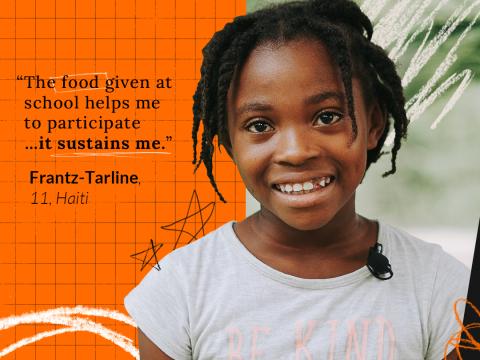
Why in the world’s most dangerous and fragile contexts, a school meal can be a child’s best hope
Amanda Rives, Senior Director for Global Humanitarian Partnerships & Policy Advocacy and advisory board member of The State of School Feeding report, underscores the lifesaving role of school meals in fragile and conflict-affected settings. For many children, a daily meal at school is their only source of nourishment, safety, and hope. Amanda calls on global leaders to step up with sustained funding, stronger local ownership, and bold policy action to ensure no child is left behind.
"The food given at school helps me to participate. It sustains me," says 11-year-old Frantz-Tarline from Haiti. The words of Frantz highlight a reality that resonates deeply across diverse contexts worldwide: school meals are more than just food. They are a lifeline that enables better learning, unlocks potential and serves as a critical support system for millions of children worldwide.
School meals have been shown to improve educational performance, reduce hunger, boost nutrition, offer protection and sustain mental health and psychosocial support. They transform lives, one meal at a time, across the globe. But the impact does not stop at the school gate. These programmes also stimulate local economies, create jobs and build environmental resilience. In fact, for every dollar invested, the estimated return, across sectors, is a staggering $30.
A safety net in the midst of multiple challenges
In fragile and crisis-affected settings—where children endure daily threats from prolonged conflict and are acutely vulnerable to shocks such as forced displacement, restricted humanitarian access, and deep poverty—school meals often represent the only dependable source of nutritious food. They offer stability and certainty in chaos, ultimately helping children to thrive. They also ease financial pressure on families, create employment and provide safe spaces for children. Planet-friendly school meal programmes that procure supplies from local smallholder farmers, especially hold the potential to address environmental, health, economic and other societal challenges, thus addressing multiple layers of vulnerability.
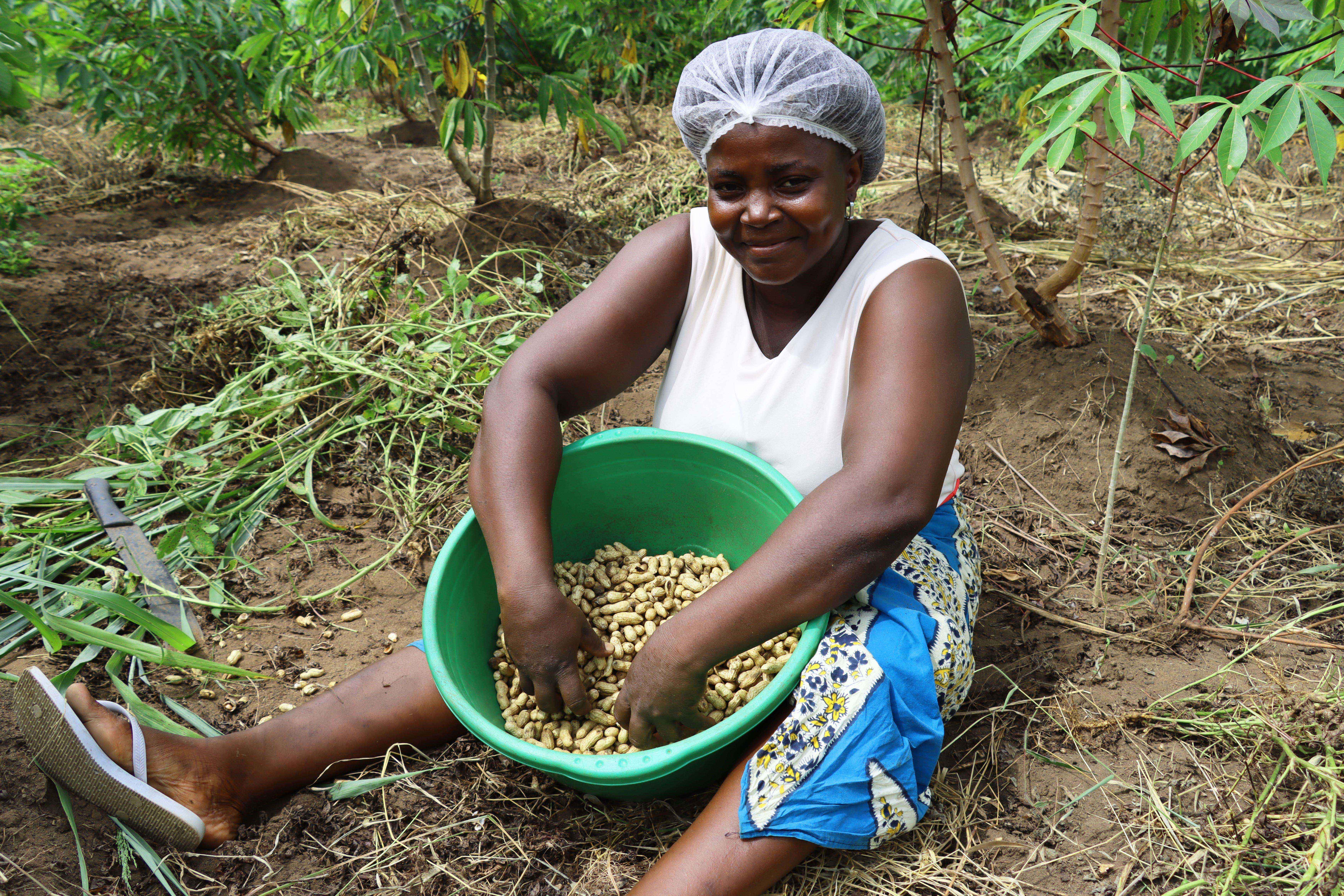
As an advisory board member of The State of School Feeding Worldwide, a WFP flagship publication which is the primary reporting mechanism of the School Meals Coalition, I celebrate the surge in domestic investment and the growing reach of school meals programmes. This progress reflects a powerful commitment by governments to nourish their children and strengthen education systems from the ground up.
While school meal programmes have demonstrated significant benefits and achieved notable progress, recent shifts in the global aid landscape—particularly reductions in Official Development Assistance (ODA)—threaten to stall momentum. This is especially concerning for low-income and fragile contexts, where such programmes remain critically dependent on foreign funding.
Even as domestic investment in school meals is growing, low-income countries remain dependent on international donors for 63% of their funding. This dependency makes them vulnerable to shifting donor priorities and funding cuts.
Progress, But Not Yet Equity
The numbers in the WFP report tell a story of both hope and urgency. Government-led school meal programmes now reach 466 million children globally—an increase of 80 million since 2020. While this marks a major milestone in expanding school feeding coverage, it also exposes a deep equity divide: nearly half of primary school-aged children remain beyond reach. Coverage in low-income countries also lags, at just 27%, compared to 80% in high-income nations, underscoring the urgent need for targeted investment and evidence-based initiatives in these contexts.
Moreover, cuts to humanitarian funding are dismantling critical safety nets in fragile settings—hitting displaced communities the hardest and deepening their vulnerability.
When school meals—often the sole source of daily nutrition for children in crisis-affected communities—are disrupted or disappear, children may lose opportunities to transform their lives, dream bigger and break free from the intergenerational cycle of poverty.
While 107 countries now report having a national school meals policy—a promising sign of global momentum—only 18% of these are in lower-income countries (19), despite this group showing the most significant growth since the last reporting cycle. This growing number of low-income governments—demonstrating political will, increasing domestic investment and committing to stronger school meals frameworks- signals a meaningful shift toward sustainable, locally-led solutions that advance both child nutrition and education.
National programmes also typically generate 1,500 jobs for every 100,000 children served—offering an economic boom for countries grappling with instability and offering pathways for wider food system transformation.
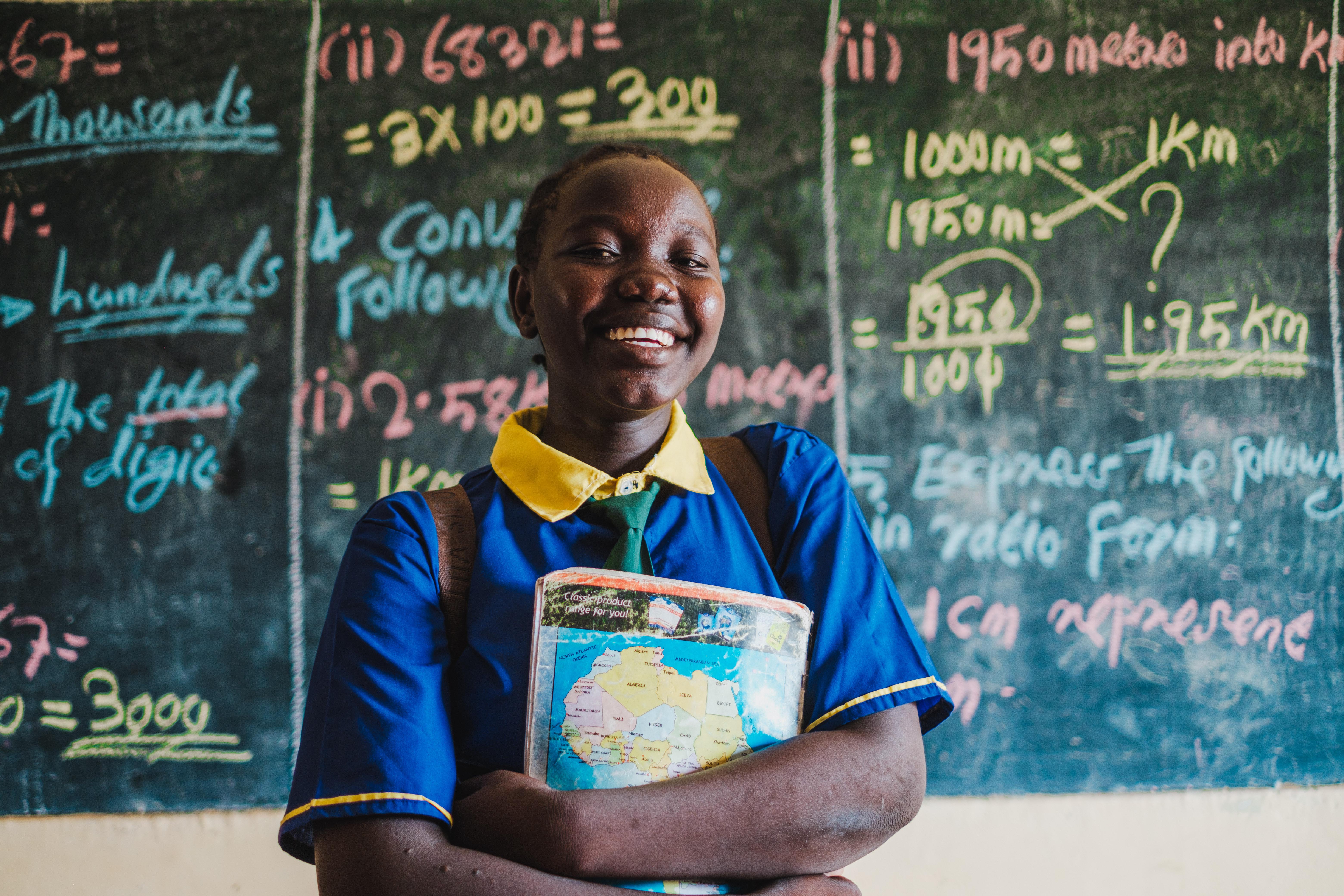
World Vision’s commitment to ensuring every child has access to school feeding
Noting the transformational potential of school meals, World Vision is working to create momentum and galvanise global action to scale up school feeding in partnership with the World Food Programme, and hundreds of other global and local actors. As a partner of the School Meals Coalition, we have expanded programmes in fragile contexts like Burundi and South Sudan, and school meals form a cornerstone of the ENOUGH Campaign—our vision and pledge to end child hunger and malnutrition.
World Vision’s approach to school feeding is comprehensive: we advocate for increased national investment, support governments in fulfilling coalition commitments, and promote locally sourced, planet-friendly meals. We are also piloting innovations like cash for school meals and school gardens initiatives to enhance sustainability and community ownership.
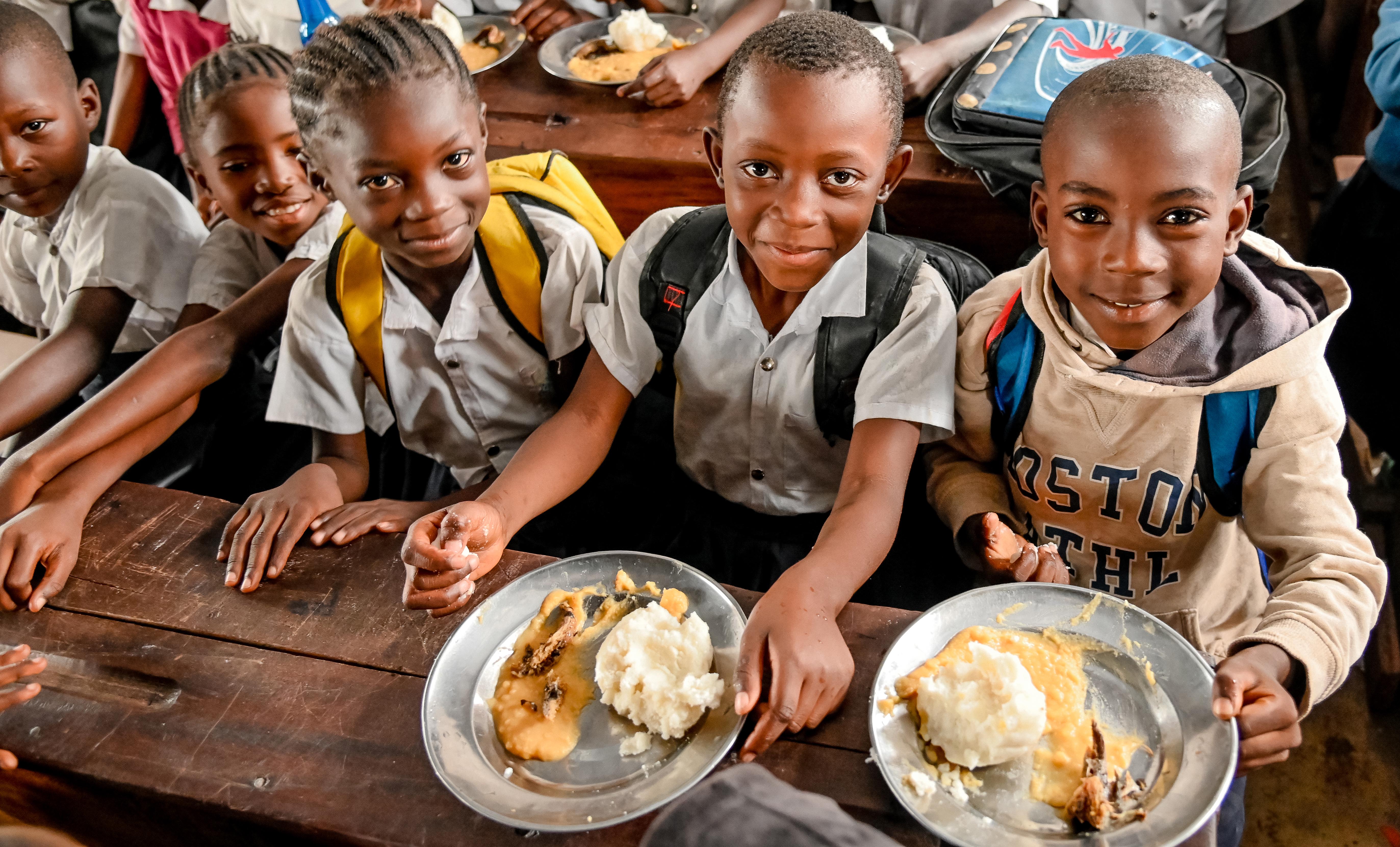
In 2024, World Vision, along with local partners, provided school meals for nearly 1 million children across 20 countries and seven regions. Of these, more than 70% of the children served (740,000) live in humanitarian settings, linked to either a complex emergency or a natural hazard. This year, Burundi and South Sudan, with a reach of 135,427 and 66,202 children respectively, host the largest school meals programmes rolled out by World Vision.
Scaling up school meals in fragile contexts: Building Global Commitment
As global leaders prepare to chart the next phase of school feeding expansion, at the 2nd Global Summit of the School Meals Coalition, in Fortaleza, Brazil (18–19 September), the urgency to reach every child with a daily school meal should be prioritised, as a key social and economic imperative.
School meals are not a luxury. They remain one of the most effective tools to combat child hunger, boost educational outcomes and strengthen communities. Yet their potential is far from being fully realised. Unlocking it demands more than good intentions—it requires sustained investment, technical expertise, political will and coordinated action. Every child, especially those living through conflict, displacement and poverty, deserves access to nourishment that stimulates learning and growth.
This requires increasing investments in sustainable food systems, with school meals at the centre. Donors and development partners must provide increased technical support and targeted funding for locally led school feeding, particularly in fragile and low-income contexts, in collaboration with local governments as a means to achieve holistic transformation. National governments must also prioritise school meals programmes within national budgets, and global partners must hold them accountable for fulfilling the commitments made as part of the School Meals Coalition.
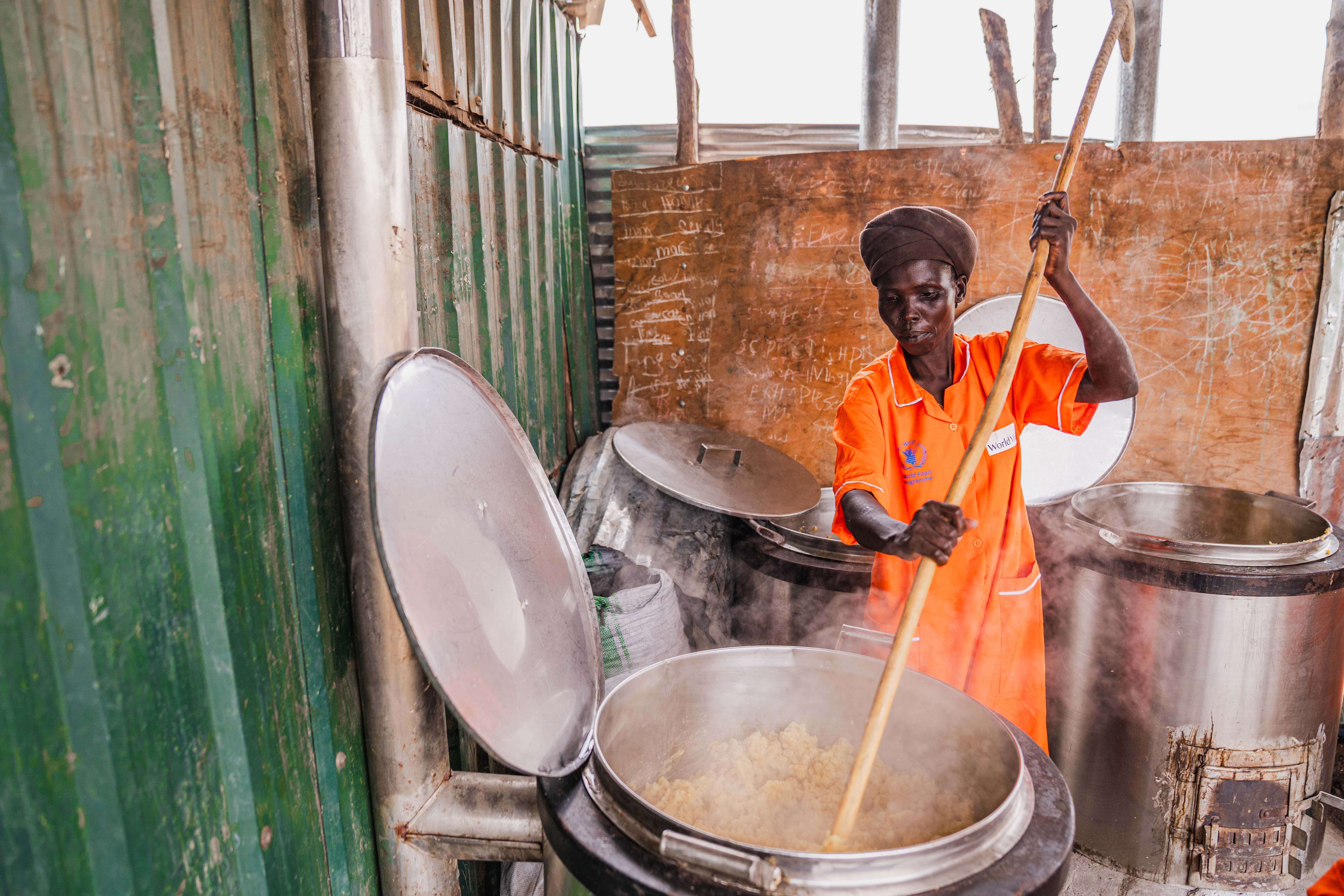
Children in crisis settings face unique vulnerabilities. School meals offer more than calories—they provide stability, dignity, safety, and hope, reaching far beyond the school grounds. It is now time to position school feeding as a cornerstone of humanitarian and development policy.
About the Author:
Amanda Rives oversees World Vision’s global humanitarian partnerships and policy advocacy as Senior Director for Disaster Management. She is an advisory board member of The State of School Feeding report, published by WFP. Before joining World Vision’s global Disaster Management team, Amanda served in Regional Advocacy Director roles in the Middle East and Eastern Europe, as well as Latin America and the Caribbean. Her portfolio has included elevating issues related to fragile and humanitarian contexts, the humanitarian-development-peace nexus, food security, forced displacement, and children in armed conflict. Amanda is a 2025 recipient of the Congressional Hunger Centre’s Hunger Leadership Award in recognition of her outstanding efforts to advance food security in humanitarian contexts. Amanda holds a BA in international affairs from George Washington University and an MA in international development from American University.
